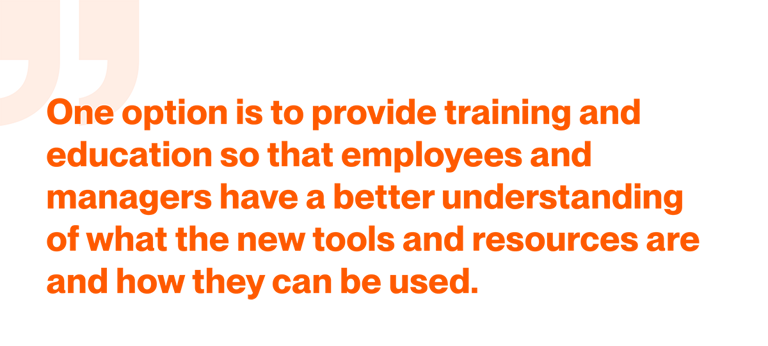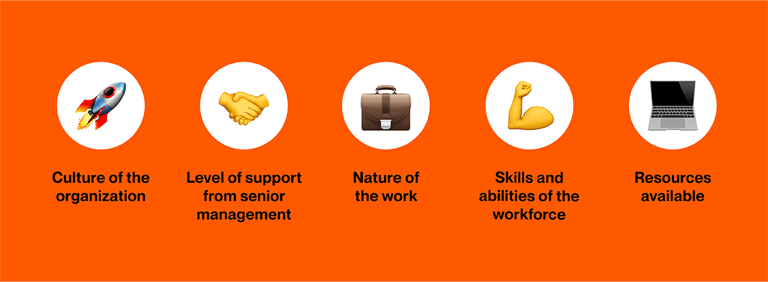How to solve issues with talent development adoption
Written by
Tigerhall Team
Posted on
Last modified on

Introduction
Talent development initiatives are essential for organizations looking to stay ahead of the competition. 86% of companies have identified they have skills gaps - which means talent development is more important than ever.
By taking advantage of new tools and resources, teams can improve their skills and capabilities, allowing them to reach their full potential. However, in order for these initiatives to be successful, it is important to address any potential issues that may arise. By being proactive and mindful of the various factors that can impact adoption rates, you can help ensure that your team is able to take full advantage of the new tools and resources at their disposal.
What is talent development adoption and why is it an existential challenge?
Talent development adoption is the process of implementing new talent development initiatives within an organization. It can be a challenge to get everyone on board with these changes, and there are a number of factors that can impact adoption rates.
One of the main reasons why talent development adoption is an existential challenge for many leaders is that it can be difficult to get engagement from the team with process, tech and cultural changes. In order to ensure that your team is able to take full advantage of the new tools and resources at their disposal, it’s important to be proactive and address any potential issues that may arise. By taking a holistic approach and being mindful of the various factors that can impact adoption rates, you can help to ensure that your team is able to achieve success.
The common and not-so-common challenges of talent development adoption
Common Challenges Faced:
Lack of leadership commitment and ownership
One of the most common challenges faced when it comes to talent development adoption is a lack of leadership commitment and ownership. Without strong leadership support, initiatives can often lose momentum and fail to produce the desired results. In order to overcome this challenge, it is important to create a clear and concise business case for talent development and make sure that all stakeholders are on board with the plan. Additionally, leaders should be actively involved in the process, and be held accountable for ensuring that goals are met. By taking these steps, you can help to ensure that your team is able to take full advantage of the new tools and resources at their disposal.
Defining the business case for talent development
One of the keys to a successful talent development initiative is making sure that the business case is clear and well-understood by all stakeholders. You need to be able to articulate why the new tools and resources are important and how they will benefit the company as a whole. By taking the time to define the business case upfront, you'll help to ensure that everyone is on board with the project and that there is broad support for moving forward.
Lack of standardization or operational consistency
One of the main challenges that organizations face when implementing new talent development initiatives is a lack of standardization or operational consistency. This can make it difficult to achieve success, as teams may be using different tools and methods, and there is no clear framework in place for how these initiatives should be implemented.
A lack of standardization can also lead to confusion and frustration among team members, as they are not sure what is expected of them. Additionally, it can be difficult to track progress and measure results when everyone is working in silos.
There are a number of ways to overcome these challenges. One option is to create a standardized framework for how talent development initiatives should be implemented. This can help to ensure that everyone is on the same page and that there is a clear process in place for achieving success. Additionally, you can establish guidelines for how teams should work together, and create standard reporting templates so that progress can be tracked easily. By taking these steps, you can help to ensure that your team is able to take full advantage of the new tools and resources at their disposal
Resistance to change from employees and managers
One of the main challenges that organizations face when implementing new talent development initiatives is resistance from employees and managers. This can often be due to a lack of understanding or skepticism about how the new tools and resources will benefit the company. Additionally, some team members may be reluctant to change the way they work or may be afraid of being overwhelmed by the new tools and resources.

There are a number of ways to overcome this challenge. One option is to provide training and education so that employees and managers have a better understanding of what the new tools and resources are and how they can be used. You can also make sure that there is plenty of support available for those who are interested in using the new tools and resources. By taking these steps, you can help to ensure that your team is able to take full advantage of the new tools and resources at their disposal.
Ineffective training and learning solutions
If training and learning solutions are ineffective, employees will not be able to learn or improve their skills as effectively as they could. This can lead to a number of problems, including a lack of productivity and innovation, and overall lower quality of work. Additionally, if employees are struggling to learn the new tools and processes required for their job, they may become frustrated and dissatisfied with their position. 49% of employees report the desire for more opportunities to grow and do new work as a key reason for leaving. This reality ultimately leads to a loss of talented employees, who may find it difficult to stay engaged in a workplace that does not provide them with the necessary resources to grow and develop their skills.
Measuring the success of talent development initiatives can be tricky
One of the main challenges with measuring the success of talent development initiatives is that there can be a lot of variability in how different individuals and groups perceive and interpret success. What might be seen as a successful outcome by one group may not be seen as such by another, which can make it difficult to develop a uniform measurement system. Additionally, the success of a particular initiative may not be immediately evident, making it difficult to track over time.
There are a number of factors that can affect the adoption rates of talent development initiatives, so it is important to be aware of them and take them into account when designing and implementing new programs. Some of the most important factors include:

By being mindful of these factors, you can help to ensure that your team is able to take full advantage of the new tools and resources at their disposal and that the investment in talent development pays off in terms of improved performance and productivity.
Uncommon Challenges Faced:
Different interpretations of what "talent development" means
When it comes to talent development, there can be different interpretations of what that term means within an organization. This can lead to confusion and frustration among employees, as they may not all be on the same page when it comes to what is expected of them. In order to ensure that everyone is on the same page when it comes to talent development, it is important to have a clear and concise definition of what that term means for your organization. This will help to avoid any confusion and ensure that everyone is on the same page when it comes to developing their skills.

Unclear roles and responsibilities
One of the main factors that can impact adoption rates for talent development initiatives is confusion about roles and responsibilities. When team members are unsure about who is responsible for what, it can lead to hesitance in adopting new tools and resources. This can ultimately hinder the success of the initiative.
There are a few ways to help mitigate this issue. First, it is important to clearly define everyone's roles and responsibilities from the start. This should be outlined in a charter or project plan, and everyone involved should be made aware of their individual duties. Additionally, it is helpful to have regular check-ins throughout the implementation process to ensure that everyone is on the same page. By taking these steps, you can help ensure that everyone is aware of their role in the initiative and knows what is expected of them.
Misaligned incentives
One of the main factors that can impact the success of talent development initiatives is misaligned incentives. If team members feel that they are not being properly rewarded for participating in or adopting new tools and resources, they may be less likely to do so. This can be especially true if there are other, more immediate priorities that seem to be more important or pressing.

In order to ensure that everyone is on board with and motivated to participate in talent development initiatives, it is important to make sure that everyone's incentives are aligned. This may include offering bonuses or other forms of recognition for those who contribute to the success of the program or developing clear goals and objectives that everyone can work towards. By taking these steps, you can help to create a positive atmosphere around talent development adoption and encourage all members of your team to get on board.
Fragmented talent development initiatives
When it comes to talent development initiatives, fragmentation can have a significant impact on adoption rates. When different parts of the organization are working on different initiatives, it can be difficult for employees to know where to turn for help or how to get started. This can lead to confusion and frustration, and can ultimately make it more difficult for employees to take advantage of the new tools and resources that have been made available to them.
In order to ensure that talent development initiatives are successful, it is important to address and solve any potential issues that may arise. By taking a proactive approach and being mindful of the various factors that can impact adoption rates, you can help to ensure that your team is able to take full advantage of the new tools and resources at their disposal.
How to overcome the challenges of talent development adoption
1. Understand and align on the incentives and motivations of different departments in the business
Getting different departments within the business to align on their incentives and motivations is both a political and sensitive approach. This can be a difficult task, as different teams often have different goals and priorities. However, without this alignment, it can be difficult to get everyone on board with the new initiative and ensure that it is successful.
There are a few things that you can do to help facilitate this alignment. First, you need to understand what drives each team and what their goals are. This can be done by holding departmental meetings and discussing the new initiative, or by conducting interviews with key members of each team. Once you have a good understanding of their motivations, you can work to align these with the goals of the talent development program.

For example, if one goal of the talent development program is to improve employee retention, you can work with the HR team to create incentives for teams that achieve this goal. Alternatively, if one goal of the program is to develop leadership skills in employees, you can work with the managers of each team to create a ladder of promotion that employees can aspire to. By aligning the incentives and motivations of different departments with the goals of the talent development program, you can help ensure that everyone is on board and working towards the same goal.
2. Evaluate the current systems or tools in place to drive or hinder talent development initiatives
The effectiveness of any talent development initiative is dependent on the systems and tools in place to support it. If the current systems are not conducive to learning or growth, then employees will be less likely to adopt the new initiatives. Conversely, if the tools and resources are effective and easy to use, employees will be more likely to take advantage of them.
It is therefore important to evaluate the current systems and tools in place and make changes as needed to ensure that they are effective drivers of talent development. By doing so, you can create a positive environment that supports learning and growth, which will lead to better outcomes for both the individual employees and the company as a whole.
3. Assess potential solutions for overcoming resistance to change
There are a number of ways to address the resistance to change and improve talent development. Some of the most effective solutions include:
Communicating the benefits of the new initiative
It is important to make sure that everyone understands why the change is taking place and what benefits it will have for them. This can help to build support for the new initiative and encourage people to get on board.
Addressing any concerns or objections
If there are any concerns or objections, it is important to address them head-on. This can help to clear up any misunderstandings and ensure that everyone is on the same page. Organizing a twice-weekly focus group session to hear the thoughts of the people who will be going through your talent development program is the fastest and most direct way to address objections head-on.
For enterprises, a mix of townhall-like virtual or in-person sessions with different groups of people in your workforce can help to break and bridge the barrier of competing concerns and
Setting clear goals and objectives
Having clear goals and objectives can help employees to understand why the change is taking place and what they need to do in order to be successful. This can make it easier for them to buy into the new system and work towards achieving its goals.
4. Follow up and evaluate the readiness and excitement of your team
It is important to follow up on the readiness and excitement of your team after introducing new talent development programs. This will help you to gauge how well the programs will be received and identify any potential issues that may need to be addressed. Additionally, it is important to periodically evaluate the effectiveness of these programs in order to ensure that they are meeting the needs of your team. Ultimately, this will help you to better implement your talent development strategy and ensures a clearer path to success.
Conclusion
Introducing new talent development programs can be a daunting task, but by addressing and solving potential issues beforehand, you can help to ensure a successful implementation. By following the tips we've outlined in this article, you can create a positive environment that supports learning and growth, which will lead to better outcomes for both the individual employees and the company as a whole.
If you are looking to accelerate employee engagement in your talent development strategy, Tigerhall’s Social Learning Platform solves the common symptoms of low employee engagement and L&D with a dedicated Learning Strategist, to customize your workforce’s learning needs. Book a demo today and see how seamless the platform is for admins and users.